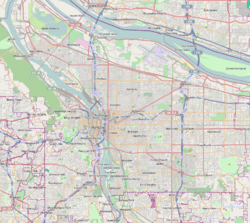King, Portland, Oregon facts for kids
Quick facts for kids
King
|
|
|---|---|
|
Neighborhood
|
|
| Country | United States |
| State | Oregon |
| City | Portland |
| Area | |
| • Total | 0.64 sq mi (1.66 km2) |
| Population
(2000)
|
|
| • Total | 5,979 |
| • Density | 9,329/sq mi (3,602/km2) |
| Housing | |
| • No. of households | 2148 |
| • Occupancy rate | 92% occupied |
| • Owner-occupied | 1119 households (52%) |
| • Renting | 1029 households (48%) |
| • Avg. household size | 2.78 persons |
King is a neighborhood located in the northeast part of Portland, Oregon, United States. It is known for its diverse community. In 2010, about 60% of the residents were white.
The King neighborhood is found along Martin Luther King Jr. Boulevard, stretching from Ainsworth Street to Fremont. It is also near the Alberta Arts District. This area is famous for its local shops, art galleries, and cafes, which have made the neighborhood lively and popular.
In the past, King was mainly home to African-American families. Since the 1990s, more young people, often white, have moved into the area. This has changed the neighborhood's feel. King is now considered one of Portland's most popular neighborhoods, and homes there are often more expensive than the city average.
Contents
History of King Neighborhood
Early Days in Albina
The King neighborhood is part of a historic area in Portland called Albina. Albina used to be its own city before it joined with Portland. For a long time, many African-American families lived in King and other neighborhoods in Albina.
Changes in the Community
Over time, some black residents moved out as rents increased. Also, some older homes were sold to new owners or renters. However, many long-time residents were able to sell their homes for a good price if they wanted to move.
King still has one of the largest groups of black residents in Portland. Because of this, it is often still called an African-American neighborhood. Even though African Americans are not the majority, they make up a large part of the community. In 2010, about 34% of the neighborhood's 8,654 residents were African American. There is also a small part of the neighborhood where African Americans are still the majority.
Notable People from King
- Esperanza Spalding is a famous musician who grew up in the King neighborhood.


